As we have fundamentally shifted how (and where) work is done, there is a new struggle: how do you define and measure ‘productivity’? Holding remote and hybrid workers accountable has become a tricky balancing act.
A Slack survey of 18,000 knowledge workers shows a major disconnect between leaders and the front line on this issue:
- For executives, the No. 1 method for ascertaining productivity is “visible activity” – that is, an active log-on, email responsiveness and office time.
- For employees, the No. 1 method they want to be measured by: the achievement of goals and key performance indicators. Only 13 percent of employees said they wanted to be recognized for the amount of time spent on specific tasks.
This also holds true for corporate Legal Departments, where “visible activity” has long since resigned as the dominant metric of productivity, reflecting the combination of corporate (vs. law firm) culture and the emotional baggage that lawyers carry of timesheets and billable hours from their private practice days.
Consider how in-house legal productivity is commonly assessed:
Benchmarks
The average in-house lawyer in a private company handles 192 contracts every year, with a turnaround time of 25.7 days, according to a benchmarking report by the Association of Corporate Counsel.
That’s well and good, but such data omits valuable context, including:
- Organization Profile: Categories like “private companies” cover so much ground they are hard to apply; is a family business with one location truly comparable to an international company? Even the most well-meaning benchmarking survey will struggle to get granular enough.
- Efficiency: Do these 192 contracts truly merit Legal Department involvement, or could they be addressed with templates or legal tech?
- Strategy: Are these 192 deals aligned with the company’s business strategy? Do they reflect “right-fit” deals – or are any of them distractions from the core focus?
- Profitability: Will these deals actually make the company money? How much?
Lists
Whether through spreadsheets or Word documents, this is the “See everything we did last quarter, we’re super busy” approach that is tedious for all involved. Done manually, it consumes valuable Legal Department time. It also puts the onus on the reader – whether C-suite or board or business unit – to decipher what this list of projects means for the business.
Sure, you have three pages of projects – but are they projects we care about? Are you productive – or just busy?
Time Logs
While breaking away from the tyranny of the billable hour is an oft-cited motivation for lawyers to go in-house, the Association of Corporate Counsel estimates that as many as 40 percent of large Legal Departments track their time in some form.
Two truths must be acknowledged: That estimate aside, most in-house lawyers are far from eager to go back to firm-style timesheets, and the time spent working on a matter is not necessarily a reflection of its value.

What's holding Legal Departments back?
Going back to the Slack survey, if people want to be evaluated for their contributions to company goals and key performance indicators, what’s holding Legal Departments back from doing so?
Obstacle 1: Lack of connection to corporate strategy
It sounds simple, but it must be said: To measure the Legal Department against company goals and key performance indicators, the Legal Department must be cognizant of and connected to company goals and key performance indicators.
High-performing (and highly productive) Legal Departments have their own specific strategies that align with corporate objectives. (This need not be onerous; Xakia’s white paper, 8 Steps to Your Legal Department Strategic Plan, will walk you through a straightforward process.)
Alignment with corporate strategy ensures that your lawyers aren’t just busy; they are spending their time on the right things. Without a direct tie to the corporate goals and objectives, you risk wasting time and resources on projects that don’t move the proverbial dial – or worse, act against what the C-suite is trying to accomplish. Maybe one business unit plans to pull out of a specific region; it doesn’t matter how many of those regional contracts you execute or how fast you execute them, you’re ultimately unproductive.
Moreover, building stronger ties to the organization has actually shown to increase productivity – more than adding capacity. Indeed, a study by Gartner – in which more than half of in-house lawyers described themselves as at least “moderately exhausted” – found the best way to combat exhaustion was to increase lawyer engagement. While adding more bodies worked “in a limited way,” “highly engaged” lawyers were more likely to find new ways to meet business needs and seek improvements to Legal Department processes – and less likely to look for jobs elsewhere.
And yet:

Obstacle 2: Lack of visibility into the work itself
To be sure, Legal Departments are busy: 76 percent of Legal Departments struggle to manage their current workload according to an EY and Harvard Law School study in 2021. When you are slammed with work, it’s hard to pause to consider process improvements or strategic alignment. And without clear visibility into the work itself, it’s darn near impossible.
Too many legal teams are mired in work without means to truly see and sort their work – to have a real-time, comprehensive view on who’s doing what, for whom, by when. Analog tracking systems (disparate to-do lists, spreadsheets, email inboxes, lawyers’ memory) keep Legal Departments stuck in assembly-line mode because the information is so flawed and siloed.
Moreover, this information lacks the context needed to evaluate what is truly “productive.” A list of projects does not convey what truly matters – the risk to the organization and the impact on its strategy.
Obstacle 3: Lack of meaningful reporting and feedback
More than half of in-house legal teams provide no internal reporting about their work, according to a poll during a recent Xakia webinar with In-House Connect. Indeed, 56 percent of teams take the approach of “We’ve always done it this way” or “We have a good relationship with the CEO.”
Only 38 percent of in-house legal teams engage in regular reporting.
While we acknowledge that when you’re in firefighting mode, reporting seems like just-one-more-thing-to-do, the importance of consistent, quality reporting cannot be overstated in the journey to demonstrating the productivity of the in-house legal department. There are many reasons why your Legal Department needs to engage in regular legal reporting:
Legal reporting forces you to hit pause
Reporting breaks you out of execution mode and, done right, lets you take the 30,000 foot view of the Legal Department to ensure your endeavours are focused in the right direction. Even if the “report” starts with a list of matters, the act of making that list will break you out of your rut.
Legal reporting makes you think
Even a no-frills Legal Department report will inspire you to revisit the last period (what happened, what lessons were learned) and forecast the next period (what’s coming up, where might we need resources). You can spot trends, such as problematic products or business units, and identify gaps and ensure productivity is maximized by directing energy where it will have the greatest impact.
Legal reporting should be a dialogue with the company
Recall the Gartner insight that lawyer burnout is best addressed not with adding capacity, but by enhancing engagement. Effective Legal Departments approach reports not as a passive piece of paper, but as the opportunity to connect with and converse with the C-suite. This means using the report as a means of better communication with the business, starting from its formation: What metrics matter most to the CEO, board and business units? What do they want to see? How do they want to see it?
Then, it’s a matter of communicating within the Legal Department: “These are the metrics on which the business will evaluate our success, and this is how we will hold each other accountable.”
Tip: Check out Xakia's Best-In-Class Legal Reporting white paper to help you get started with legal reports tailored to specific audiences.
By removing these obstacles, a measure of productivity can be achieved in a form acceptable to both executives and employees.

The ripple effect can start at the individual level, as each lawyer feels more connected to the organization and its goals, more aware of the meaning behind their work, and less pressured to churn out X number of contracts in Y hours each day. It extends to the team, as every report provides a rallying cry of Legal Department successes. It extends to the business, as the Legal Department evolves beyond the Department of No to be seen as a resource and a business partner.
And maybe, just maybe, it extends throughout the profession, breaking lawyers away from the emotional baggage of timekeeping and lists and hollow “visible activity” measures of productivity, and leading them toward more fulfilling careers where productivity means knowing you have made a difference.
A modern matter management software can show how your Legal Department is performing
Modern matter management can make it easy to automate legal reports and dashboards and to show, visually, how the Legal Department has performed on actual productivity standards: on protecting risk, on driving strategy forward, on contributing to profitability.
With a legal matter management software, Legal Departments can automatically collect the “vital statistics” of a project – the who, what, when and such – while also capturing its heart: risk profile, strategic value and complexity. This makes it easy then to analyze the work and look for new ways to boost productivity.
To learn how Xakia's legal analytics software can demonstrate the value and productivity of your in-house Legal Department, get in touch with one of our experienced consultants today for a demo, or sign up for a 14-day trial.
